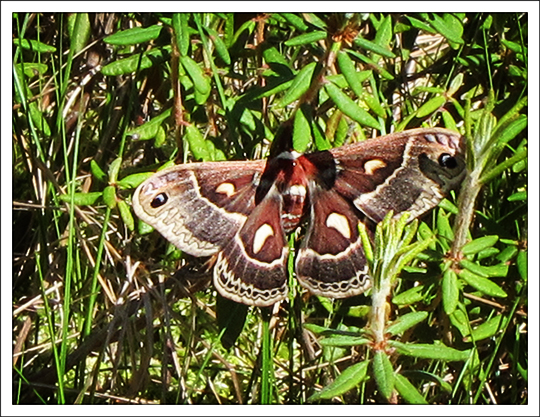Moths of the Adirondack Mountains:
Columbia Silkmoth (Hyalophora columbia)
 Moths of the Adirondack Mountains: Columbia Silkmoth on the Boreal Life Trail (3 June 2011)
Moths of the Adirondack Mountains: Columbia Silkmoth on the Boreal Life Trail (3 June 2011)
| This page is no longer being updated. For an updated version of this material, see: Columbia Silkmoth (Hyalophora columbia). |
The Columbia Silkmoth (Hyalophora columbia) is a large moth which may be seen occasionally in the Adirondack Mountains in upstate New York from late May through June. [1] It is also called the Columbia Moth. Its larva is known as the Larch Silkworm - a reference to its host plant (the tamarack, also called the larch). [2]
The Columbia Silkmoth is a large moth with mainly reddish brown wings and body, easily confused with the Cecropia Moth. The wings of the Columbia Silkmoth have crescent-shaped markings in the middle of both the fore wing and the hind wing, although occasionally the spots on the fore wing may be small or absent. [3] There is a large black spot near the apex of the fore wing. [4] Each wing also has a stripe with two color layers: black and white. This contrasts with the stripe on the Cecropia Moth, which also has a reddish orange layer. [5] [6] The tips of the wings of the Columbia are rounded. With a wing span of eight to ten centimeters, [7] [8] this moth is smaller than the Cecropia. [9]
Female Columbia Silkmoths lay one or two eggs at the base of larch needles. Caterpillars appear in less than two weeks. The adults do not feed. [10]
The Columbia Silkmoth habitat includes forests with boggy, acidic soil. [11] [12] This moth is found in a limited range from eastern Canada to northern Wisconsin. [13] Its limited range is due to the fact that it breeds primarily on the tamarack, which is mainly confined to swamps and bogs. [14]
The potential flight period of the Columbia Silkmoth in our area is from late May through June.[15] However, this moth appears to be relatively rare, as sightings of the Columbia do not appear to be common in the Adirondack Park. In both 2011 and 2012, there apparently were no sightings recorded by Project Silkmoth. [16] [17] The BugGuide data base lists only two sightings in the Adirondack Mountains; both were in Lake Placid (Essex County) in June 2011. [18] A Columbia Silkmoth was seen near the boardwalk of the Boreal Life Trail in early June 2011. [19] The boardwalk traverses Barnum Bog, which has numerous tamaracks -- the moth's preferred host plant. A Columbia was also reported in early June 2004 in the northeastern part of the Adirondack Mountains, in an wooded area with tamaracks. [20]
References
- Susan Grimm Hanley. Interpretive Naturalist, Paul Smith's College Native Species Butterfly House. Species Logbooks.
- Butterflies and Moths of North American. Species Profiles. Sighting record: 6/3/11
- Project Silkmoth. Columbia Moth (Larch Silkworm).
- Project Silkmoth. 2012 Sightings Map.
- Project Silkmoth. 2010 and 2011 Sightings.
- Bugwood Wiki. Larch Silkworm.
- World Field Guide. Hyalophora Columbia.
- Iowa State University. Department of Entomology. BugGuide.
- Charles V. Covell, Jr. A Field Guide to the Moths of Eastern North America (Houghton Mifflin Company, 1984), p. 52, Plate 10.
- David Beadle and Seabrooke Leckie. Peterson Field Guide to Moths of Northeastern North America (Houghton Mifflin Harcourt Publishing Company, 2012), pp. 256-257.
